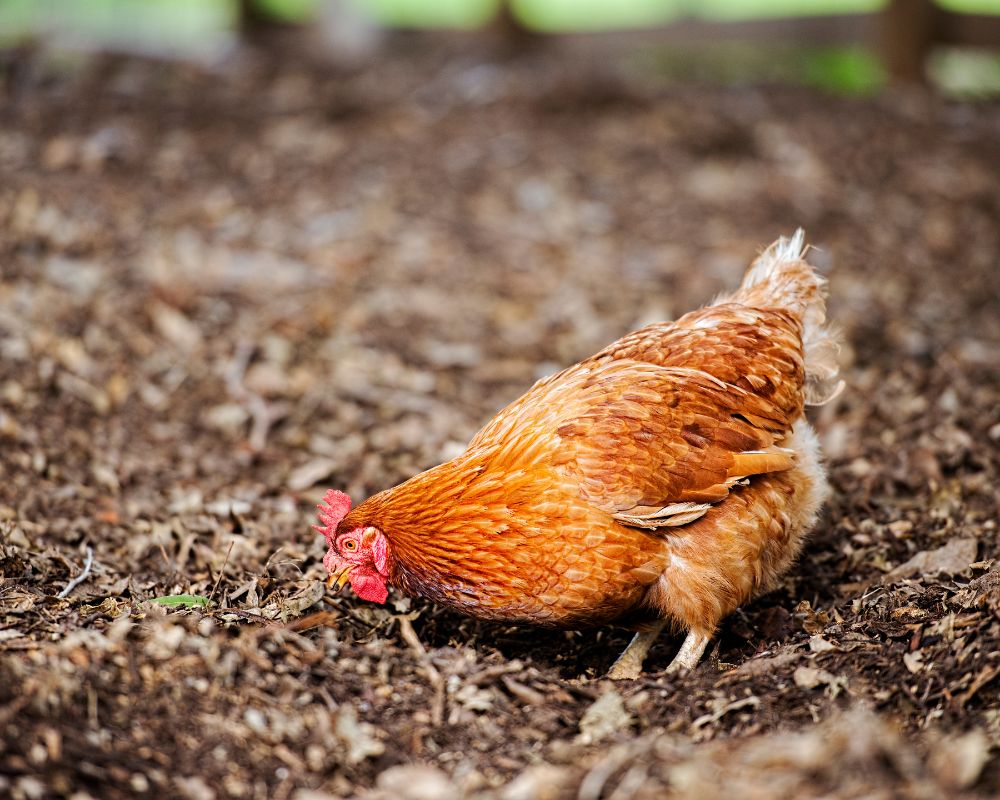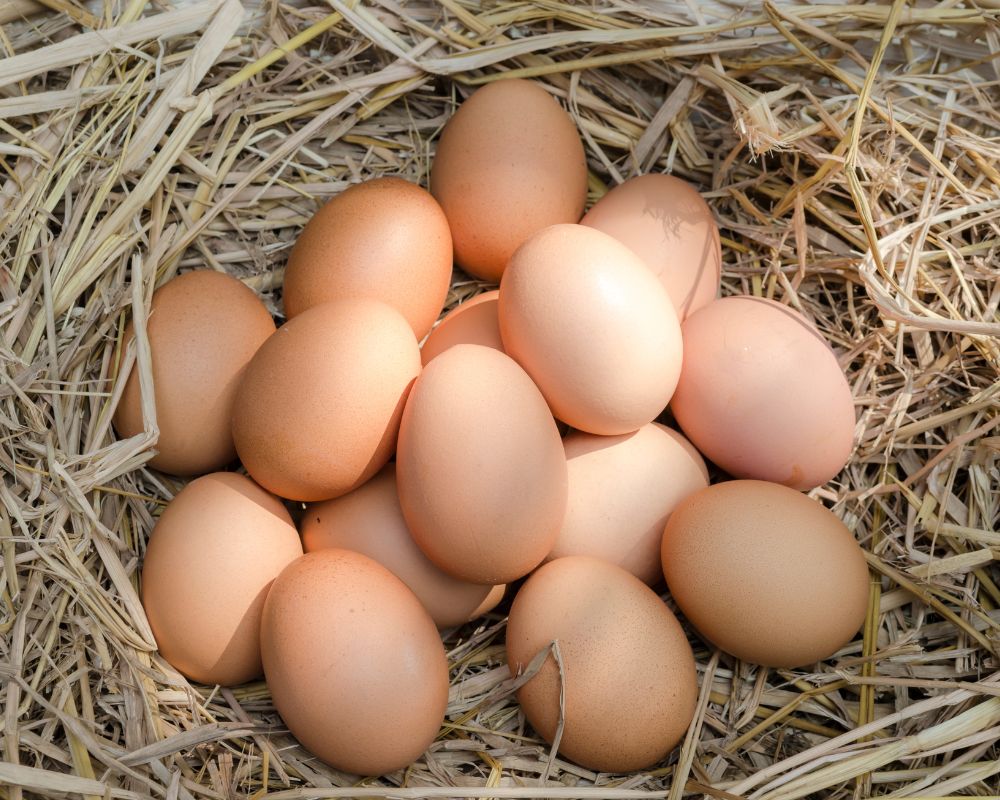Chickens lay anywhere from 60 to 300 eggs per year, with their quantity based on breed rather than climate, diet or easy access to nesting boxes. The popular ISA Brown breed are egg-laying machines and are best for those who are seeking reliable eggs every morning.
All breeds of chickens have their strengths and weaknesses. For example, Rhode Island Reds, and their relatives the Rhode Island Blues, are known for being excellent egg layers and will on average lay about 250 eggs per year. Other breeds such as the Cornish Cross are known for their excellent meat, but they will only lay about 150 eggs per year.
In this article, we will look at the egg production of some of the most popular chicken breeds.
Table of Contents
Laying Averages of Most Popular Chicken Breeds (Chart)
| Breed | Average Eggs/Year |
| Silver Dorking | 170-190 |
| Plymouth Rock | 200 |
| Marans | 150 |
| Barred Rock | 250 |
| Easter Eggers | 200-250 |
| Black Silkies | 120 |
| Buff Orpingtons | 150-200 |
| Ameraucana | 250 |
| Australorps | 250-300 |
| White Leghorns | 280 |
| Wyandotte | 200 |
| Cochin | 150-180 |
| Speckled Sussex | 250 |
| Polish | 200 |
| Rhode Island Red | 260 |
| Dominique | 250 |
| Barnevelder | 150-200 |
| Brahma | 130-150 |
| Plymouth Rock | 280 |
| Belgians | 100-150 |
| Minorca | 170-220 |
| Sebright | 60-80 |
| Old English Game | 100-150 |
| New Hampshire Red | 200 |
| Welsummer | 160 |
| ISA Brown | 300 |
| Sapphire Gem | 280 |
| Golden Comet | 280-300 |
| Andalusians | 160-200 |
How To Improve Your Chicken’s Laying Ability
There are many factors that can impact how well your hen will be able to produce eggs. Focus on the following two and they will reward you with a bounty of eggs.
1. Access to daylight
A hen’s ability to lay eggs is dependent on the hours of daylight that she gets, also known as photoperiod. Hen’s on average need about 14 hours of light daily to optimize the egg production cycle. Light is integral to keeping a hen’s hormones balanced for their reproductive cycle to continue.
Depending on where you live, you might want to consider running an artificial light during the day if you don’t have enough natural daylight. It’s important to remember to turn off the light before your chickens go to sleep for the night. Since hens are so sensitive to light, getting excess light in their roost will negatively impact the number of eggs they can produce.
2. Fed a well-balanced diet
A hen will be happy and healthy if she’s getting the right nutrients she needs through what is known as a layer feed. Layer feed is formulated to optimize egg production.
These feeds are normally around 16 percent protein and have extra calcium supplements which will help them produce strong egg shells. Meal worms make for a perfect treat for egg layers as they are high in protein.
External Influences on Laying Abilities
Some factors that can change your hen’s laying potential can also be out of your control. One of the biggest external factors in egg laying is the change in seasons.
Most hens will slow down and potentially stop laying eggs entirely during the winter. Since the days will naturally grow shorter, the lack of sunlight will decrease your hen’s hormone levels. As the hormones go down, a hen will drastically reduce the amount of eggs that she will produce.
If a hen becomes sick or injured, they won’t be healthy enough to produce nearly as many eggs. Parasites, predator attacks, illnesses such as bumblefoot, issues in pecking order, molting, and overall stress are all common causes of reduced egg production and quality.
Another major issue that hen’s face is when they go broody. A broody hen will focus on hatching eggs, and more often than not, will stop producing eggs completely.
Can Chickens Lay 2 Eggs a Day?
No, a healthy hen will be able to only lay 1 egg every 24 to 26 hours. A chicken can only produce one egg at a time due to its reproductive system. After an egg is laid, a new egg will start to form in the ovary shortly afterward.
Most hens will not be able to lay an egg every single day, as their reproductive systems need some time to recover before the next egg cycle begins.
How Long Do Chickens Lay eggs?
After growing out of their pullet stage, a young hen will usually start laying eggs somewhere around 16 to 20 weeks old. While their first eggs might seem small, they will gradually increase in size and quality as time goes on. Once a hen is about 30 weeks of age, she’ll be in her prime for egg production and the egg size will be at its largest.
The first year of laying will usually be the peak amount of eggs that hen will lay per year in her lifetime. By the second year, the quantity she will lay will only be about 80 percent of what she produced in her first year. For example, If she laid 200 eggs during her first year, she will likely lay only 160 eggs in her second year.
A hen will continually lay fewer and fewer eggs with every season until she reaches about 6 or 7 years when she might retire altogether. Most laying hens only have a life expectancy of about 8 to 10 years. So, as a chicken keeper, it’s very likely that you’ll eventually have older hens in your flock that no longer lay eggs.
What Breeds of Chicken Lay the Most Eggs?
There are several breeds of chicken that are known to be the best egg layers. Most egg-laying breeds are developed specifically with high egg production as the goal in mind.
The following list contains the top 5 egg laying breeds out of the 30 most popular breeds of chickens:
1. ISA Brown – 300 eggs per year
2. Golden Comets – 280-300 eggs per year
3. White Leghorns – 280 eggs per year
4. Sapphire Gems – 280 eggs per year
5. Australorps – 250-300 eggs per year
These are all fantastic options for prolific egg-laying chickens.

ISA Browns lead the pack by laying 300+ eggs per year while being fantastic and hardy birds that can withstand the winters with wonderful, calm personalities. They make for a perfect breed for first-time chicken keepers because they are so friendly, can get along with the rest of your backyard flock, and will lay you many, many eggs.

